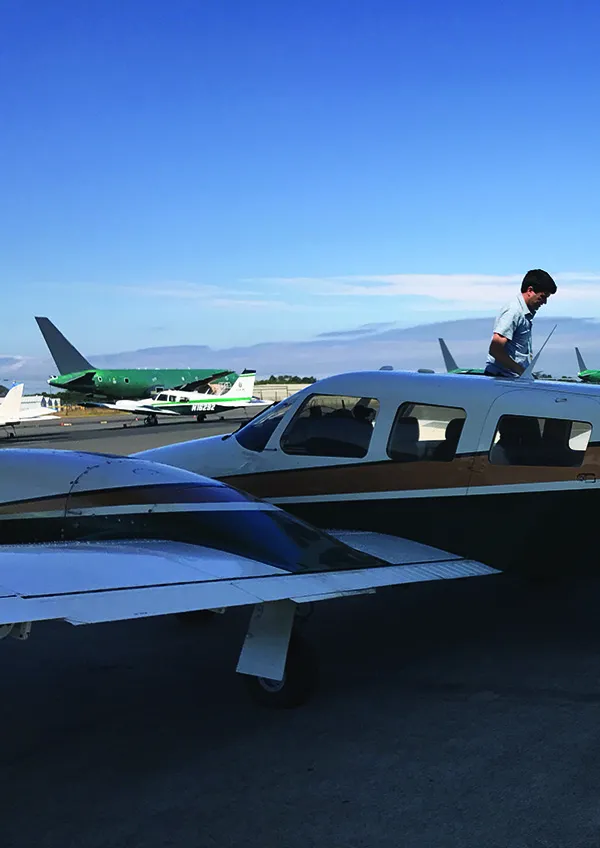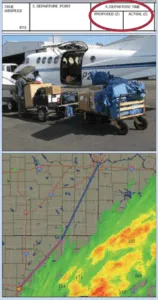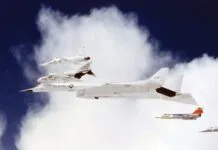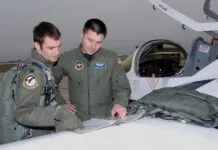
One thing all pilots feel at some point on any flight is a sense of pressure. On a good-day local flight, it could be something as simple and routine as wanting to make an “are-we-down-yet-smooth” landing to impress someone. At the other extreme might be a boss who absolutely, positively needs to be at a meeting and is depending on you to fly through challenging weather on minimal fuel to get there in time. In the former example, that pressure is self-imposed and of short duration, with the outcome almost totally in your control. The latter example, though perhaps extreme, is more representative of the kinds of pressures under which pilots operate, few of which are in our control. Most often, however, pilots face a series of more subtle pressures, only some of which may be in our control. But all of them contribute to how well or poorly we fly.
Researchers tell us there are two basic kinds of pressure we may experience as pilots: internal and external. Internal pressures, pretty much by definition, are self-imposed. External pressures result from factors outside our control, like no-nonsense bosses and their demands, and bad weather. Something to keep in mind is that pressure, whether self-imposed or resulting from external forces, often results in stress. And stress in turn too often leads to making mistakes as we rush through a procedure or let adverse possible outcomes dominate our thinking and soak up our mental bandwidth.

“Everyone has a plan ‘til they get punched in the mouth.” So said former heavyweight boxing champion Mike Tyson, something that should ring true to anyone who’s attempted an even moderately complex task. Flying personal airplanes certainly meets that definition, so it shouldn’t come as a surprise that when things don’t go as planned, pressures mount. How we react to individual stress points and their collective impact on us can mean the difference between success and failure. Some typical stressors and their solution may include:
Meeting Schedules
This is something of a no-brainer, and usually falls into the self-imposed, internal-pressure basket. As such, it’s easier to control. It’s also something you can anticipate and head off at the pass by building in flexibility, overestimating en route times and padding ETAs.
Weather
Weather is always a stress point, and always will be. One key is having enough flexibility to wait it out or go around. Stress associated with weather increases if you don’t think you’re proficient enough to handle it. The best solution may be to stay on the ground.
Mechanicals
We’re all tempted from time to time to take an airplane that has an inoperative item or three. And without reviewing the maintenance records, there’s no way to know if everything’s copacetic, including with the FAA. This stressor is one best resolved well before the day of the flight, on an ongoing basis.
Illness
Being perhaps somewhat more independent than most of the population, pilots tend to minimize the effects of any sniffles or mobility problems. A runny nose might not be a problem until you can’t clear your ears at altitude. And if you can’t get in the plane without assistance, how will you get out in an emergency?
SELF IMPOSED?
I first started flying IFR in the aftermath of the 1981 PATCO strike, the catalyst for President Reagan to fire striking FAA air traffic controllers. One outcome of that action was severely understaffed ATC facilities. To manage system demand, the FAA imposed something called GAR—the general aviation reservation system.
It was similar to today’s special traffic management programs at major fly-in events. As I recall now, GA pilots had to give the FAA some sort of information about a proposed IFR flight, including departure point and the planned time off, up to 24 hours in advance. Once the reservation was made, you received a confirmation number that had to go in the flight plan’s remarks block, and you were expected to request clearance within some relatively tight timeframe, based on the proposed flight plan. If for whatever reason you requested a takeoff clearance outside of that timeframe, there was a chance ATC wouldn’t approve it.
I never had that happen, but there was a lot of preflight stress in getting to the airport, inspecting the airplane, loading and strapping in before calling for clearance within the defined timeframe. I carry some of that urgency with me today: deep down in my lizard brain, a proposed departure time must be met as closely as possible.
Of course, that’s nonsense. Outside of a major fly-in event, there’s no IFR reservation system now, and even if the flight plan is dumped from the system, it’s a simple thing to update it and refile.
This is a classic example of (mostly) self-imposed stress. Sure, the FAA’s short-staffed ATC facilities and reservation program bear some lingering responsibilities, but the fact of the matter is that those were my formative years as in instrument-rated pilot. As any flight instructor or other educator will confirm, the Law of Primacy applies: What is learned first often creates a strong, almost unshakable impression. Back in the day, I learned that my ability to fly in the IFR system depended on meeting my proposed departure time, something I still try to do today, but at which I often fail miserably. My initial reaction to a takeoff delay is to freak out that I’ll lose my place in line. Then I remind myself there’s no line, and that particular pressure point goes away.

The FAA Pilot’s Handbook of Aeronautical Knowledge (PHAK) defines stress as “the body’s response to physical and psychological demands placed upon it. The body’s reaction to stress includes releasing chemical hormones (such as adrenaline) into the blood and increasing metabolism to provide more energy to the muscles. Blood sugar, heart rate, respiration, blood pressure, and perspiration all increase.” The PHAK also defines two kinds of stress, other than internal and external:
Acute Stress
“Acute stress involves an immediate threat that is perceived as danger. This is the type of stress that triggers a “fight or flight” response in an individual, whether the threat is real or imagined. Normally, a healthy person can cope with acute stress and prevent stress overload. However, ongoing acute stress can develop into chronic stress.”
Chronic Stress
“Chronic stress can be defined as a level of stress that presents an intolerable burden, exceeds the ability of an individual to cope, and causes individual performance to fall sharply. Unrelenting psychological pressures, such as loneliness, financial worries, and relationship or work problems can produce a cumulative level of stress that exceeds a person’s ability to cope with the situation. When stress reaches these levels, performance falls off rapidly.”
EXTERNAL FACTORS
Although self-imposed, internal stress always can be a factor in the cockpit. The good news is we can control it. External factors that create stress can be a bit more of a problem, however.
One thing I don’t need to do here is include a list of external pressure sources—you know what stresses you out way better than I do. I also won’t say something clueless like, “You can’t let it get to you,” or, “Just chill out.” What I will suggest, however, is that one of the best ways to avoid external factors that contribute to your overall stress level is to fix, repair, minimize or eliminate whatever it is that’s stressing you out.
No one can do much about an airborne minimum fuel situation, for example, or the boss’s schedule changes, or the destination airport that just went below minimums. You probably can’t fix what you didn’t break. But you can take control of the situation. After all, you’re the pilot in command, and it’s up to you to use your authority to take whatever actions you deem appropriate to alleviate the stress imposed by both internal and external pressures.
Of course, that can be easier said than done when your boss threatens dismissal if you don’t get to the destination on time. The long-term solution to such behavior is to find another job, and pilots are in growing demand right now. If flying isn’t your job description, but it’s still part of your livelihood and a source of stress, you need to analyze in detail what’s stressing you out and address it.
But in those situations where taking control is within your purview and you have the tools to do it, do it. If a passenger shows up with a too-heavy steamer trunk, it’s your role to reject it outright or force the passenger to repack. It’s not your fault someone didn’t get the memo, nor is it your fault the airplane chosen for today’s flight can’t carry the load and make the trip nonstop. It can be difficult to explain the loading realities of a general aviation airplane to someone whose only flying experience is in the back of a 737, but that’s your role.
Delays figure prominently in the FAA’s assessment of how external pressures contribute to stress. The Risk Management Handbook tells us, “Management of external pressure is the single most important key to risk management because it is the one risk factor category that can cause a pilot to ignore all other risk factors. External pressures place time-related pressure on the pilot and figure into a majority of accidents.” But a simple way to manage delays and schedules is to pad them, and then maybe pad them again.
That external pressures contribute to accidents shouldn’t be in dispute. Classic accident causes like scud-running or continuing VFR into IMC typically result from our old “friend” get-there-itis, a condition often resulting from someone else’s expectations. On one level, these accidents are a result of poor decision-making. But poor decisions typically result when under stress, which results from internal and/or external pressures. The key here is recognizing when you’re about to make a poor decision, something that often comes as a result of having made poor decisions before, and paid a price.
Trite sayings like erring on the side of caution, sticking with your standard operating procedures and not exceeding your operational comfort levels all resonate with a tinge of cluelessness about what causes stress and its potential impact. But situations that place you, the aircraft and its passengers at greater risk should always loudly ring that alarm bell. The challenge is doing something about it.

The FAA Risk Management Handbook breaks down three basic sources of stress confronting pilots:
Environmental Stress
“Conditions associated with the environment, such as temperature and humidity extremes, noise, vibration, and lack of oxygen.”
Physiological Stress
“Physical conditions, such as fatigue, lack of physical fitness, sleep loss, missed meals (leading to low blood sugar levels), and illness.”
Psychological Stress
“Social or emotional factors, such as a death in the family, a divorce, a sick child, or a demotion at work. This type of stress may also be related to mental workload, such as analyzing a problem, navigating an aircraft, or making decisions.”
CONTROLLING WHAT YOU CAN
Again, you’re the pilot in command, and you have the final authority as to operation of the flight. When it comes to pressures, stress and decision-making, your only real challenge should be recognizing the situation for what it is. That’s relatively easy in many cases, since events outside the ordinary that threaten the plan you’ve made exert pressure on you and create stress. How you respond to the additional stress determines whether the flight will have a safe outcome.
Each challenge you face in the cockpit has a solution, which may be as clear-cut as landing somewhere and regrouping. It may also involve not taking off at all. The real dangers involve the bandwidth you consume in worrying about the outcome, which in turn can make the worst-case scenario a reality. That’s the insidious part of pressure and the stress that results, and it has no place in the cockpit.
Jeb Burnside is this magazine’s editor-in-chief. He’s an airline transport pilot who owns a Beechcraft Debonair, plus the expensive half of an Aeronca 7CCM Champ.



